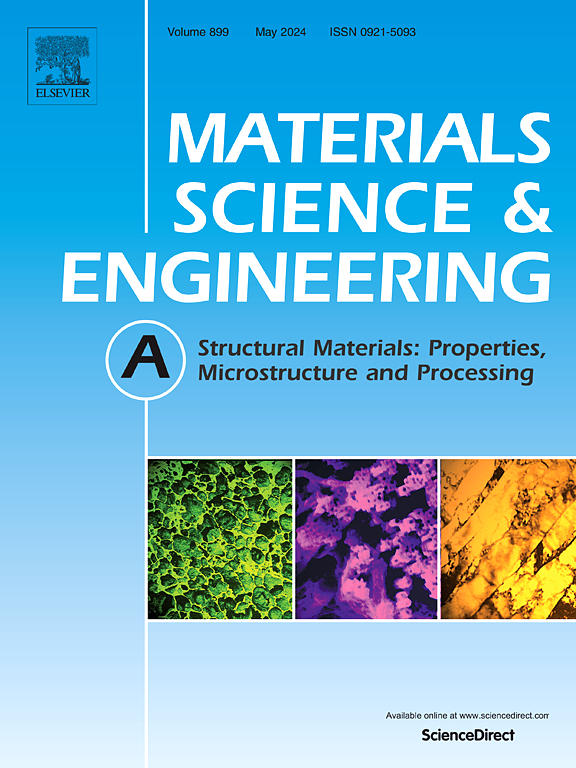不同冲击速率下Cu-Cr-W合金的显微组织及动态压缩行为
IF 6.1
2区 材料科学
Q1 MATERIALS SCIENCE, MULTIDISCIPLINARY
引用次数: 0
摘要
本文报道了采用机械合金化和火花等离子烧结两种方法制备不同Cr含量的Cu-Cr-W合金。采用场发射扫描电镜和透射电镜对Cu-Cr-W复合粉末和合金样品的微观形貌特征、元素组成和显微组织细节进行了仔细观察和分析。采用霍普金森压杆装置研究了不同冲击速率下Cu-Cr-W合金的动态压缩行为。利用电子背散射衍射综合评价Cu-Cr-W合金试样动态压缩后的相组成、晶界特征、几何本质位错密度和反极图。实验结果表明,在烧结过程中,Cr能与W相反应形成Cr0.5W0.5固溶体。此外,Cr的加入改善了W颗粒在Cu基体中的分散均匀性。随着Cr含量的增加,Cu-Cr-W合金抗动态压缩的能力显著提高。这主要是由于Cr在Cu-W合金内部产生的多种强化机制的协同作用。对于掺杂4 at的Cu-W合金。当冲击速率为2800 ~ 3000 s−1和3800 ~ 4000 s−1时,其动态抗压屈服强度分别达到839 MPa和828 MPa。与未添加Cr元素的Cu-W合金相比,这些值分别提高了32.1%和33.8%。本文章由计算机程序翻译,如有差异,请以英文原文为准。
Microstructure and dynamic compression behavior of Cu-Cr-W alloy under different impact rates
This study reports on the preparation of Cu-Cr-W alloys with varying Cr contents achieved through mechanical alloying and spark plasma sintering methods. Field emission scanning electron microscopy and transmission electron microscopy were employed to carefully observe and analyze the micro-morphological features, elemental composition, and microstructural details of the Cu-Cr-W composite powders as well as the alloy samples. The dynamic compression behaviors of Cu-Cr-W alloys under different impact rates were investigated using a Hopkinson pressure bar device. Electron backscatter diffraction was utilized to comprehensively assess the phase makeup, characteristics of grain boundaries, geometrically essential dislocation density, and inverse pole figures of the Cu-Cr-W alloy specimens after dynamic compression. Experimental results demonstrate that during the sintering process, Cr can react with the W phase to form a Cr0.5W0.5 solid solution. Additionally, the addition of Cr improves the uniformity of the dispersion of W particles in the Cu matrix. As the Cr content rises, the ability of the Cu-Cr-W alloy to resist dynamic compression improves significantly. This is mainly attributed to the synergistic effect of multiple strengthening mechanisms generated by Cr within the Cu-W alloy. For the Cu-W alloy doped with 4 at.% Cr, at impact rates of 2800–3000 s−1 and 3800-4000 s−1, its dynamic compressive yield strengths reach 839 MPa and 828 MPa respectively. Compared to the Cu-W alloy without the addition of the Cr element, these values are 32.1 % and 33.8 % greater.
求助全文
通过发布文献求助,成功后即可免费获取论文全文。
去求助
来源期刊

Materials Science and Engineering: A
工程技术-材料科学:综合
CiteScore
11.50
自引率
15.60%
发文量
1811
审稿时长
31 days
期刊介绍:
Materials Science and Engineering A provides an international medium for the publication of theoretical and experimental studies related to the load-bearing capacity of materials as influenced by their basic properties, processing history, microstructure and operating environment. Appropriate submissions to Materials Science and Engineering A should include scientific and/or engineering factors which affect the microstructure - strength relationships of materials and report the changes to mechanical behavior.
 求助内容:
求助内容: 应助结果提醒方式:
应助结果提醒方式:


